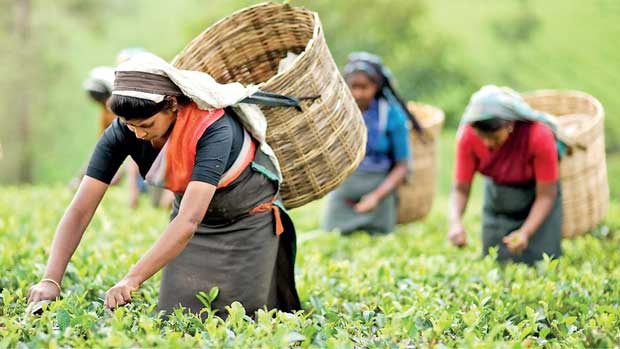Reply To:
Name - Reply Comment
Last Updated : 2024-04-26 10:26:00

 This refers to the article titled ‘Poor-quality decision-making, main cause for destruction of plantations’, written by Lalin de Silva, which appeared in mirrorbusiness of 22.04.16.
This refers to the article titled ‘Poor-quality decision-making, main cause for destruction of plantations’, written by Lalin de Silva, which appeared in mirrorbusiness of 22.04.16.
At the outset let me point out that recognizing the need for greater public awareness through debate on key issues affecting Sri Lanka’s plantation industry and constructive criticism thereof is always appreciated by the regional plantation companies (RPCs), Planters’ Association of Ceylon (PA) and industry stakeholders.
Lalin De Silva, in his latest error-ridden article, has in the most derogatory manner, ridiculed, insulted and resorted to the lowest levels of name-calling and personal attacks against the CEOs of the RPCs and industry stakeholders. Despite these attacks, it should be noted that the RPCs managed by the said CEOs sustain a population of approximately one million (who reside in plantations) and contribute substantially by adding a revenue of Rs.77 billion from only tea, rubber and palm oil crops (without considering any value addition) to the local economy.
While it is deplorable for one to misuse media space in the guise of exploring solutions to the serious issues facing the industry to launch personal vendettas, having to resort to childish name-calling and personal insults can only reflect one’s own shortcomings of character, inability to validate one’s claims and provide even a single workable constructive solution. We will simply dismiss such irrelevant and personal attacks, which reflect one’s juvenile nature and lack of fulfilment in life.
Regrettably, in his haste to condemn the PA and RPC CEOs, the writer has failed to get the most basic of facts correct, thus misleading the readers. He has stated, “The first privatization of lands by then Agriculture Minister, the late H. Kobbekaduwa way back in 1972,” when even those with a basic knowledge of the industry are aware that the privatization took place in 1992. This error at the beginning appears to have set the tone for the rest of the article, which too is nothing but inaccuracies, blunders, flaws set in a confused, incoherent manner.

Errors in even the most basic facts
For instance, according to the article, ‘Powysland Esate, Agrapatana’, which is over 200 hectares in extent, is a smallholding. However, a smallholding is classified as an extent which is less than 10 acres (four hectares) in size, indicating that the writer is regrettably not even aware of the basic distinction between a smallholding and otherwise.
Since the writer has repeatedly questioned whether the CEOs of the RPCs are qualified to manage their respective companies, it is only appropriate to examine the writer’s own credentials to comment as a so-called ‘expert’ on the field and to advice the CEOs of the RPCs.
The writer has hypocritically demanded that all CEOs of RPCs must have MBAs when he himself has only sat for his Ordinary Levels. Furthermore, despite joining the plantations sector at 23 years of age and being in the sector for over 30 years (till he left at 57 years of age), the writer has failed to obtain a single professional qualification from the National Institute of Plantation Management (NIPM).
Many of the RPCs are group companies of Sri Lanka’s largest and respected conglomerates. It would be abundantly clear to any rational individual that the boards of directors of entities of such calibre would not even consider appointing as the CEOs of RPCs individuals without the necessary qualifications and expertise. In any event, the majority of CEOs have globally recognized the industry as well as professional qualifications.
Apart from the lack of any academic or professional qualifications indicating the expertise in the field, the writer’s career as a planter too fails to inspire confidence. In his 13 years as an Assistant Superintendent, he has moved around continuously – serving in six estates in three organisations. Even after privatization, in a span of 13 years, he has flitted from one estate to another in five different estates in five different organisations in the same capacity.
While the writer has never shied away from advising all on improving yields in tea estates, even at the height of his career, in an estate at which he served with more than 75 percent vegetatively propagated (VP) tea, the yield per hectare (YPH) was only a paltry 900 kilos. The loss per kilo doubled during his tenure to more than 64 percent the prevailing labour wage, equal to a Rs.390 per kilo loss in current terms. After he left, the estate performed at normal levels. Even in the face of unprecedented plummeting prices, the CEOs of the RPCs have performed better by a massive margin, which again raises doubt on the ability of the writer to provide advice on the plantation sector to the CEOs of the RPCs.
Superior performance following privatization
The article at the outset claims that the plantations are being ‘systematically destroyed’ – while all data indicates the exact opposite (as explained in detail below). In particular, it is worthwhile to note that it is under the management of the RPCs that the country began to earn a premium for Ceylon tea – which was earlier lower in price than that of Kolkata, etc.
All the official records and many high-powered committees appointed by the government have confirmed that by the time the estates were handed over to the RPCs that ‘they continued to make heavy losses’ and ‘performed poorly throughout most of its existence’. The operational losses were Rs.1.5 billion per year, equal to Rs.13 billion now and the Treasury had to subsidize Rs.5 billion a year, equal to about Rs.19 billion at present. Although a debt of Rs.4 billion was converted to equity by 1990, a further debt of Rs.3.3 billion was added, equal to a total debt of Rs.7.7 billion – an amount now equivalent to Rs.20 billion. All these are on official record.
At the very recent Tea Sector Committee meeting convened by the Prime Minster with the presence of the most qualified set of people with expert knowledge of the plantation industry, it was clearly stated that if the estates had not been privatized in 1992, they would have ended up incurring a staggering loss of over Rs.300 billion.
However, since privatization, the RPCs have made a cumulative profit of Rs.26 billion, paid Rs.7 billion to the state as lease rental, Rs.3 billion as taxes, Rs.7 billion as dividends to the shareholding Sri Lankan public, absorbing a management fee of Rs.11.6 billion. What is most significant is that although the total cumulative profit was only Rs.26 billion, more than twice that, Rs.55 billion was invested back into the RPC estates as capital expenditure clearly demonstrating the commitment of the RPCs.
From the figures available with the Plantations Industries Ministry, the total tea production of RPCs in 1992 was 80.2 million kilos and in 2013, the RPC production was 91.1 million kilos, an increase of 14 percent although the land extent in bearing decreased by 19 percent (84,778 ha to 68,909 ha). YPH increased by 36 percent from 1992 to 2013. The 36 state-managed estates (: Janatha Estate Development Board (JEDB) and Sri Lanka State Plantations Corporation (SLSPC)) declined to 64 percent of their 1992 crop.
Comparing performance with state-owned entities
For 2012, the RPCs made a profit of Rs.7.20 per kilo. In contrast, the losses made by the state-owned entities in the same period were as follows: JEDB Rs.96.92 per kilo, SLSPC Rs.59.76 per kilo and Elkaduwa Plantations Rs.126.87 per kilo. The 36 state-managed estates are in arrears of close to Rs.3 billion on their statutory dues of the Employees’ Provident Fund (EPF), Employees’ Trust Fund (ETF) and gratuity and still the government has to subsidize them to the tune of Rs.1.5 billion a year.
From 1980 to 1991 under state management, the average cost of production (COP) for a kilo of tea was 138 percent of the daily wage of a worker. On the same ratio now, the COP should be in the region of Rs.856 per kilo. However, current the RPC COP is around Rs.450, demonstrating the efficiency brought about via private sector management.
Even in 1991, before the RPC takeover, the COP was Rs.61.58 and this was a 118 percent ratio of the then daily labour wage. If the present RPCs adopt this ratio, the COP should be in the region of Rs.732 per kilo. Even in 1991, the loss per kilo of Rs.6.93 was equal to 13 percent of the daily labour wage, although the net sale average (NSA) was 105 percent of the wage. On the same basis, the RPCs loss should be about Rs.80 per kilo with a NSA of Rs.651 but now the NSA is as low as 62 percent of the labour wage.
The loss made by state-managed estates in 1992 was Rs.41.50 per kilo and that equalled to 67 percent of the ratio of the daily labour rate in 1992. Likewise, if the RPCs use the same ratio, our losses should be Rs.415 per kilo. However, the RPC losses are less than Rs.50 per kilo in spite of the unprecedented drop in tea prices which is beyond the control of the producers.
RPCs’ role in increasing price of Ceylon tea
From 1978 to 2001, except 1984, Sri Lanka’s tea sale price in US dollar terms was always less than Kolkata prices as per the Tea Board annual statistics. From 2002 to 2015 our prices have been the best in the world. The quantity of fertilizer used reduced drastically to 58,600 MT, about 70 percent of the average fertilizer applied from 1982-1991 period of around 84,000 MT. The YPH came down to 1,260 kilos by 1991 from a level of 1304 kilos in 1981 for JEDB and for SLSPC – the YPH dropped to 1188 kilos from 1200 kilos levels in 1988.
Furthermore, despite Lalin de Silva’s claims to the contrary, statistics show the significant replanting carried out by the RPCs. The VP percentage in JEDB was only 20.5 percent and for SLSPC it was only 17.2 percent by the time the estates were handed over to RPC management in 1992. By 2012, our VP percentage was at 58 percent, a very significant increase from the time the RPCs took over due to the vast investments committed by the RPCs for replanting. From 1981 to 1991, the JEDB replanted/newly planted 7,240 hectares and SLSPC 9,327 hectares of tea. The RPCs have replanted/newly planted 24,373 hectares by 2012 and are still continuing to do so annually.
The writer has repeatedly mocked the RPCs as to why the RPC estates are not achieving 3000 kilos YPH under RPC management. At the time the estates were handed over to RPCs, although the JEDB had 20.5 percent of its extent in VP, 12.4 percent was yielding between 1600-1800 kilos YPH, 4 percent at 1800-2000 kilos YPH and only 2.5 percent above 2000 kilos YPH. For the SLSPC with 17.2 percent VP, only 8 percent yielded between 1600-1800 kilos YPH, 3 percent at 1800-2000 kilos YPH and only 2 percent at 2000 kilos and above YPH.
Irrefutable evidence
Considering this irrefutable evidence, no reasonable individual can claim that the plantations are being ‘systematically killed’ unless perhaps he/she is completely unaware of these facts, despite attempting to pose as an ‘expert’ in the field. Is it not a travesty of justice that flies in face of all the available evidence? The writer’s vintage planters had their say, did it their own way and had the opportunity to showcase their performance. It is now most ironic that through bitter and misleading statements they are attempting to impose something that they did not do themselves.
On the other hand, most of the well-respected, competent, unblemished and accomplished planters and CEOs appreciate and give wise counsel to RPCs who are grappling with many challenging issues now and the whole planting fraternity respects them. The PA and the RPCs maintained their silence against many uncalled for and unethical attacks only because of the code of behaviour and professional decorum of planters.
However, personal attacks are unacceptable. Doing so by exploiting the serious issues in the industry (which is a threat to the livelihoods of many individuals), under the guise of providing solutions to these issues is especially deplorable. Hence, we would be failing in our responsibility if we do not respond to such bitter and factually incorrect accusations.
The suggested new wage model
The ex-editor has claimed that advocating a different wage model with the consensual agreement of all the RPCs is ‘a fierce propaganda by anti-Sri Lankans who are in concert with the agendas by political giants in the Indian Ocean who are competing with us’. Alleging that the RPCs are ‘engaging in espionage’ as in spy novels of old can only suggest one’s own over-active imagination and complete lack of grasp of reality, at a time all stakeholders are doing their utmost to find solutions to serious issues.
Considering his comments on the topic it is very doubtful whether the writer has any clue at all of the ‘productivity-based’ or the ‘revenue share-based’ remuneration models that the PA/Employers’ Federation of Ceylon (EFC) has put forward. He appears to be completely unaware that these mechanisms are highly common in the plantation industry across the world. We have never seen him at any of the deliberations regarding these proposals or at any of the meetings we have had with the related stakeholders.
He admonishes the PA spokesman for not exercising caution in making ‘degrading’ statements to the media, while engaging in bitter personal attacks. The PA, founded in 1854, is second in vintage only to the Ceylon Chamber of Commerce. For the PA to have achieved 162 years of continuous activity through various vicissitudes and challenges is to have acquired an undeniable distinction of service to the industry and to the nation and have been so recognized by all who matter.
Therefore, the writer’s sanctimonious and hypocritical lectures to the PA are superfluous, especially given his questionable credentials – having no professional/academic qualifications or a proven track record, as described previously.
(Roshan Rajadurai [(MCPM. FIM (SL). FIPM B.Sc, MBA (PGIA. University of Peradeniya) Dip. in Plantation Management (NIPM), Dip. in Marketing (LBS), Dip. in Marketing (UK)] is the Chairman of the Planters’ Association of Ceylon)
Chandra Wickramatunge Monday, 09 May 2016 07:07 PM
Dear Chandra. Just in case you did not get the paper.Regards. Wickrema

Add comment
Comments will be edited (grammar, spelling and slang) and authorized at the discretion of Daily Mirror online. The website also has the right not to publish selected comments.
Reply To:
Name - Reply Comment
US authorities are currently reviewing the manifest of every cargo aboard MV
On March 26, a couple arriving from Thailand was arrested with 88 live animal
According to villagers from Naula-Moragolla out of 105 families 80 can afford
Is the situation in Sri Lanka so grim that locals harbour hope that they coul